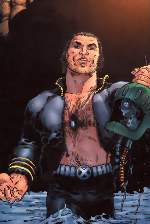[
This post is part of an issue by issue look at Grant Morrison's New X-Men run. To read the other posts, hit the New X-Men label at the bottom of this post.]
I think I made a mistake to talk about the
New X-Men Annual last time in the context of Magneto, because it obscured something fundamental -- the Annual is a wonderful issue and my small complaint about Sublime feeling like the wrong kind of villain was the only thing keeping Morrison's first four
New X-Men issues from perfection. That needs to be kept in mind.
It is in
New X-Men 117 that the tiny crack of Sublime in the annual grows into a bigger problem. 117 does not sink the ship -- that comes in the next issue, with the Korday art -- but it is with 117 that we begin to sense something has gone
fundamentally wrong.

The hauntingly beautiful cover by Quitely gives way to a first page that in any other
X-Men book would be fine: a chicken-man mutant is running through the snow.

I imagine people will jump all over me for being insensitive here, but I think it needs to be said -- while the X-Men have always been about freaks and outsiders like Beak, I was surprised and disappointed to see him become a focus in Morrison's
New X-Men, which is supposed to be about pop sexy post-human cool. There are certainly cool ways to do freaks -- Coney Island comes to mind -- but this does not seem like one of them. Like Mr. Sublime, Beak seems like a holdover from an earlier, pre-Morrison era. Morrison will redeem him in the end with an ultra-cool descendant, but for many issues Beak will be there, making me feel something is off on every page on which he appears. What happened to Quitely's fashion model spreads?
We are then treated to a two page spread of the freak students and human protesters, and again, the whole thing feels ancient. Morrison injected a lot of life into the
X-Men with his first four issues but a good bit drained out with protesters with signs like "It's not murder if its a mutant." That's lame, and sadly realistic, but lame and sadly realistic are not the tone for this book. That is the tone for much of
Watchmen, or
Jimmy Corrigan. These are small complaints so far, just hints that something has gone wrong, and I don't want to make too big a deal of them. Much bigger problems appear in the next pages.
VanSciver's Beast -- like VanSciver's art genreally -- does not look nearly as cool as Quitely's, probably because he does not have Quitely's weird design sense, or Quitely's magical ability to make anything work. VanSciver also does not work with the script: Xavier says to Hank that he looks happy, and Hank agrees, but he looks positively depressed. Then his girlfriend breaks up with him over the answering machine while he is admiring himself in a mirror -- Morrison wants pathos, I think, but the sitcom staging descends into bathos (though I am not 100% sure Quitely would have saved Morrison here as the moment seems unredeemable, but Quitely does work miracles). VanSciver also draws a wooden bat, when a character refers to it as aluminum, and again slides into bathos when a tormented Beak is on his knees, clutching ripped feathers and holding them up to god as he screams at the sky like King Lear. King Lear the chicken man. Thanks.
And then we get Casandra Nova hiding in Xavier's brain. Like fifteen minutes ago she was -- horrifically and shockingly -- to mutants what mutants are to humans. Now, suddenly without warning, she is Xavier's evil twin. And not a metaphorical twin (at least not yet, but give it a few issues) -- she is his evil
genetic twin. Morrison has abandoned a great idea for a cliche. He might have saved the cliche -- he is very good at that actually -- but changing to one midstream is just mind boggling, in the worst way. He will fumble this ball a few more times before the finish line.
VanSciver is again a big weak point, not exactly selling the "Nova Revealed" moment (a key moment in the run). Nova uses psychic powers to attack Hank's self-esteem (there is that lame old-fashioned theme again). VanSciver decides to dramatize this by drawing Hank surrounded by upsetting words: Pain, Ugly, Stupid, Bad, Child, Nightmare, Hurt.

This fails on a number of levels, the most obvious being (1) it reminds me of a Nicktoon commercial telling kids how words can't hurt them, and (2) it is painfully literal. This second problem is best illustrated by the
Beavis and Butthead episode when they watch the video for Tag Team's "Whoop There It is" and Butthead says sagely that it would be a great video to teach kids to read because they say "Whoop" and then the word "Whoop" appears on the screen.
The final page spread is a marvel of terror and wonder as we see Nova, in Xavier's body, looking at the Shi'ar battleship -- and the aliens that have come to get him -- like a cat with a canary. Sadly, the previous 21 pages suck a lot of the promise out of a powerful moment.
EDIT: Two mistakes. I wrote "Scrivner" but the artist's name is VanSciver. That has been changed. Also we have one more issue with VanSciver before Kordey shows up, and so I deleted the last sentence of the post which was "The next issue will take that promise, and beat it to death in an alley with a chain."











 Oh, this is certainly my favorite comic book cover of all time.
Oh, this is certainly my favorite comic book cover of all time.











